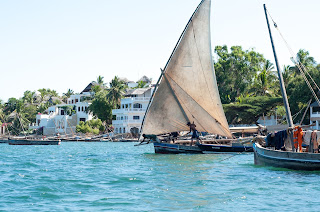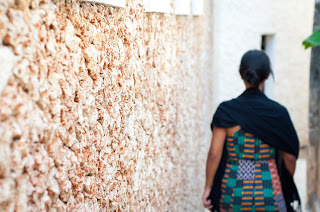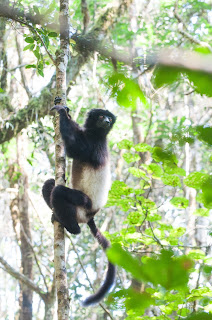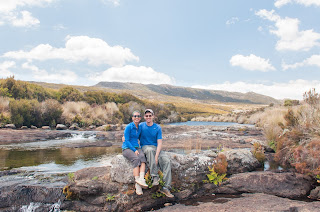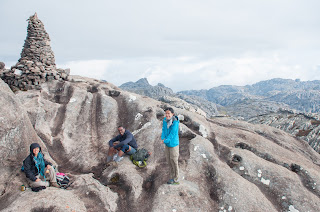2016 was fast and full. Two families visiting, work trips, fun trips, Madagascar twice in two months- it was over in a flash. 2017 may be even faster, with many new adventures. I feel like I'm at the top of the Tsaranoro valley again, looking at the new and beautiful landscape spreading out before me and thinking how much I'm going to enjoy exploring it.
31 December, 2016
29 November, 2016
The New Thanksgiving
As
an American, there’s no better scale on which to measure the give and take of
living abroad than Thanksgiving. How do you celebrate a holiday about home,
family, and the onset of chilly weather in an equatorial place 7,000 miles
away? Falling so close to Christmas, it’s also the only major celebration that
I’ve consistently spent apart from family all 6 years, and I would guess I’m
not alone in that.
When
it comes to how to celebrate in a place like Kenya or Zambia, you have choices.
Hunting down a frozen turkey or killing a live one, a massive patriotic
gathering or an intimate meal, the options are many. But there’s never any
question that your day will be weighed against past Thanksgivings and those
happening back home- what you brought with you, and what you left behind. My
personal Thanksgiving story arc moves from preserving and recreating tradition,
to embracing an almost entirely unrecognizable new celebration.
My
first Thanksgiving, in Zambia, was the first (and last) time I hosted dinner
and cooked my own turkey. It was an event replete with homages to home, down to
a fireplace video loop projected onto a wall. The setting wasn’t fancy, I
remember throwing a tablecloth over our washing machine when we ran out of
tables, but the multi-cultural gathering was warm, loving and about as close to
home as I could get.
Each
year since, I’ve moved slowly away from this direct translation as the holiday
began to develop a new life based on friends gathering and comfort food.
Eventually, even the near-religious importance of key food like green bean
casserole (which I don’t think I ever ate in the US) began to drop away, and
last year was the first I did without turkey.
This
year, though, was the grandest departure yet. As a small group of friends we
celebrated on the tropical coast of Kenya, in the ancient island city of Lamu.
We rented a stunningly beautiful house with endless reading nooks, light and
airy Swahili architecture, and even a small pool. Not only did we not cook a
single traditional Thanksgiving dish, we didn’t cook period: we hired a chef
with the house who prepared an amazing meal of fresh lobster and crab that
evening. With not a pumpkin pie or cranberry sauce in sight, and near 100%
humidity, it was a happy Thanksgiving celebration nonetheless.
Yet,
at the end of the day, American traditions or not, Thanksgiving isn’t complete
without the (new) traditional evening video call back to Massachusetts just as
the family is starting to gather. Passed around from one relative to the next,
glimpses of foreheads and feet and drinks in hand, someone inevitably taunting me
with the appetizers I’m missing, warm wishes all around. It’s not much, but it
has always been that crucial digital foot in the door, keeping me connected,
keeping me eternally weighing and remembering. On Thanksgiving, wherever it is,
I’m thankful for family, for friends, for plenty in my life, and, of course,
for good internet.
(Lamu town)
(Inside our house)
(Traditional lateen sail dhow)
(Coral-walled alleyways)
30 October, 2016
The Big Red Island
Is
there a place in the world with harder names to say and spell than Madagascar?
As far as I know, it takes this accolade for Sub-Saharan Africa. It can also
lay regional claim to the most unique mix of cultures and settings that I’ve
ever seen. With its stunning rock formations, prolific rice paddies, and quaint
cottage-style houses, it evokes South Africa, Asia, and 1800s English
countryside all at once. And that’s just at a superficial level- the language,
the food, the incredible rarity of everything in the environment truly make
Madagascar the most unique place I’ve ever visited.
A
number of factors made this was a challenging trip to plan, as Emily can
attest, so hopefully this itinerary and suggestions will help others more
easily get to know the ‘big red island’ as well.
Car rental: Madarental
One of these challenging things to figure out was how to get around.
First, we had to accept that almost all car rental places there require you
have a driver. We had originally wanted to drive ourselves, but in the end we were really glad we were forced to- it was definitely a good thing. We ended up going with Madarental (madarental@yahoo.com),
even though there were some mixed reviews online, because they seemed to have
nice 4x4s at an affordable rate (about $60 per day). The driver is as important
a consideration as the car, though. Our driver Rija truly made our trip- if you
book with Madarental, definitely request him. Another thing worth noting: they
didn’t have a bank account at the time, so double check beforehand if they’re
expecting payment in cash (and which currency). Overall we were very happy with
our experience.
Day
1: Antananarivo to Antsirabe
Stayed
at: Le Trianon
We
landed in Antananarivo (Tana) in the early evening. We were an hour late but
the arrival process was quick- we easily got cash from the ATMs, picked up a
sim card with data from Orange, and met Patrick and Rija from Madarental out
front. We efficiently signed the contracts and paid half the cost upfront in
dollar, giving us time to leave for Antsirabe straight away. Generally, drivers
don’t work after 7pm, and it’s good to minimize time spent driving in the dark
(which in October begins around 6pm).
We
skirted Tana proper and, despite some evening traffic leaving the city, arrived
at Le Trianon in Antsirabe in time for a late dinner. Le Trianon was a nice
little spot with a decent restaurant and clean rooms. Not sure if people stick
around Antsirabe for long, but this is a great hotel if you’re passing through.
Day
2: Antsirabe to Ranomafana
Stayed
at: Chez Gaspard
We
left fairly early in the morning, pre-8am, so we could cover the 5-hour drive
in time to take an afternoon hike in Ranomafana National Park where it’s common
to see lemurs. This ultimately proved to be unnecessary for a couple reasons:
the park closed earlier than we thought (we arrived around 2pm after stopping for
lunch, and were told it would close at 4) and the park fee (per walk) is
substantial, around $45 per person including guide fees.
We
decided to go on just one walk, early the next morning when we were told the
lemurs were more active. It does seem fairly common to be able to see lemurs,
in part probably because the guides all radio each other and the groups
inevitably converge on any lemur sighting. However, if you’ve got the 5 hours
to spare I’d recommend taking the longer route to improve your chances.
The
lodging options for Ranomafana seemed pretty slim online, but I recommend Chez
Gaspard- it was a lot nicer than we expected.
Day
3: Ranomafana to Massif de l’Andringitra
Stayed
at: Tranogasy
We
saw our lemurs on the walk this morning- some were relaxing, other launching
themselves through the trees at an impressive pace. They’re pretty amazing, and especially cool because they are totally unique to Madagascar. 90% of Madagascar’s wildlife
is found nowhere else in the world thanks to splitting from the continent 88
million years ago. Tangent: in addition to the 100+ species of lemurs that
currently live on the island, there used to be giant lemurs, now extinct, that
weighed over 300 pounds. That’s a big lemur.
(Lemur spotting)
This
day was a little tight. In order to get to Tranogasy by the
evening, we had to start our lemur walk right when the park opened and keep it to less
than 5 hours. Tranogasy is the setting-off point to hike Pic Boby, and the last
leg of getting there is 2 hours of rough roads with little wooden bridges that you’d
want to avoid driving in the dark if possible.
It
took us about 3 hours to get to Fianarantsoa where we had lunch and grocery
shopped for the hike. Ambalavao is the last town before the Andringitra park, but Fianarantsoa is the
last big town (including ATMs), so recommend doing everything here. Good to know: everything closes in Madagascar on Sundays including the grocery
stores. We had to plan our camping meals around canned foods from little shops
and gas stations, and veggies from the market. It turned out to great, but we
had to scramble to scrape it together.
Leaving Fianarantsoa around 3, we were still in the dark for about half of the bad road.
A number of people told us this section would take 4-5 hours, but in a good 4x4
driving normally it only took us 2.
Tranogasy
was a little difficult to find, a process further complicated by a sudden rainstorm. Turns out, it’s literally adjacent to the park office, which you can see just to the left
when you reach the sign for the park entrance. It’s bare bones, just a staging
place for a night to hike the Massif, but they’ve got a restaurant and will
cook you a good hot meal and help you get organized for your hike.
Day
4: Tranogasy to Pic Boby base camp
Stayed
at: camped in the park
Pic Boby is the highest accessible peak in Madagascar. Its strange name came out of a particularly dumb story about a European explorer losing his dog Boby while
hiking. I think we can all agree that the Malagasy name Imarivolanitra, “close
to the sky”, is a much more fitting. A few things about hiking Pic Boby /
Imarivolanitra that are useful to know:
You can let the park service know you’re coming by emailing them at
ecoshopmnp@gmail.com, but you don’t need to make a reservation. You can easily buy
your tickets and pay other fees the morning of at the park office, though you
should budget 45min for all this.
Tranogasy can arrange the guide and porters for you once you’re there.
They offer an expensive package including food that we opted not to get- it was
very easy to just arrange informally once you’re there. You can pay the porters
to cook your meals if you’d like. If you do this, they’ll also sort out making
the cooking fire.
If you do it the informal way, you need to bring your own food and
cooking gear, as well as camping gear. We were caught out on cooking gear due
to some misinformation, but it turned out to be easy to just rent essential
cooking gear (pot, pan, spoon) from Tranogasy for a couple dollars. They were
fine with it, and the porters returned it for us afterwards.
If
you stay at Tsara Camp or in the Tsaranoro Valley after the hike as we did, we
learned it’s easier to just hike directly there across the Massif rather than
returning to Tranogasy and driving as we’d originally planned. This method adds
an extra camping night, or turns 1 day into a long but not terrible hike (which
was the option we chose), but I’d highly recommend it. It was incredibly
beautiful to hike the entire way, especially descending into the valley at the end.
The
hike from Tranogasy to basecamp is pretty short, maybe just 4 hours. However,
because we didn’t leave until around 9am, we opted to stay at basecamp in the
afternoon rather than trying to rush to summit Pic Boby before dark
(particularly because the evenings seemed to get consistently cloudy and
rainy).
Stayed
at: Tsara Camp
Waiting until day 2 to summit meant we had to leave at 4am and hike for a few hours in the dark.
It’s quite steep, but only about 3 hours up. It was misty and cloudy going up,
but this created very cool effects when the clouds started to break near the
top. The weather then became beautiful and warm on the way down.
(Chilly summit break)
Stayed
at: Satrana Lodge
After a solid night’s sleep at Tsara Camp we set off
for Isalo first thing in the morning in order to get a full day there. Isalo is
another park with its own style of impressive and beautiful rock formations and
different species of lemurs. It offers lots of hiking options which can easily
be arranged through your lodge, none of which we took advantage of. Post Pic
Boby we were just looking to relax. We had a nice lunch in Ihosy on the way;
another demonstration of the amazing variety of dishes available even at little
roadside restaurants (at this place alone we had turkey, eel, fish, prawns, and
steak). Also a good time to mention that homemade yoghurt was being sold everywhere we went and it was delicious!
Satrana
Lodge was our ‘splurge’ hotel, even though it was still reasonably priced. It’s
situated in a picturesque spot, at the foot of a rocky hill with a beautiful
view into the park. It’s a short drive into the open access area of the park,
where you can watch sunset at
La
Fenêtre de l'Isalo. The safari ‘tents’ are
spacious, comfortable, and boast cozy patios and excellent outdoor showers. We
debated between staying here, Le Relais de la Reine, and Isalo Rock Lodge,
which all got good reviews. We actually stopped by these other places and were
pleased to find that Satrana is the nicest in person.
(Satrana Lodge)
Day
7: Isalo
Stayed
at: Satrana Lodge
We
spent the entire day at Satrana, reading, relaxing and briefly enjoying the
pool (it was a little chilly with the wind). Satrana’s dinners were good;
though everyone’s favorite menu item was the croque madame we had for lunch
(then special ordered for breakfast the next day).
We
brought a bottle of wine to the top of the adjacent hill for sunset this
evening, a relatively easy hike that actually yielded a nicer view than La Fenêtre. We all really appreciated the relaxation time, but it’s probably worth
budgeting another day here to give you time to explore the park.
Stayed
at: Hotel Sakamanga
While
we heard mixed reviews of the reliability of domestic flights, particularly Air Madagascar, we decided it was a worthwhile risk to take to signficantly cut
down on driving time. So, rather than driving all the way back to Tana, we
drove the few hours to Toliara, flew from there, and paid for an extra 1 day of
car rental and 2 tanks of gas for Rija to take the vehicle back. We didn’t have
any issues or delays, but probably worth building in a buffer before an
international flight. Later on, Emily and her sister used Madagasikara Airways,
a new private airline, for a domestic flight, which seemed to get better
reliability marks.
We
only had time for a brief seafood lunch in Toliara before rushing off to the
airport. We were back in Tana and checked into our hotel by the early evening.
After some persistence, we were able to secure a table at La Varangue, a
restaurant multiple people recommended to us. The food and décor were great,
but my favorite part might’ve been the flavored
rhum
arrangé, a local specialty.
Day
9: Tana
Stayed
at: Hotel Sakamanga
Antananarivo
is a city on a hill, with a quaint old town perched on top with nicer
restaurants, old buildings and a few tourist sights. I honestly wasn’t
expecting much, there isn’t a city center with big buildings and it has a
small-town feel. However, I think we were all pleasantly surprised and really enjoyed
our time there.
Sakamanga is a great place to stay. The places has lots of character and offers
nice rooms and food options. The cheapest rooms are very affordable and still
very nice. Everything was walkable from Sakamanga, and it seemed fine in the
daytime despite many Trip Advisors stories of pickpocketing. We had breakfast
at a nice pastry shop at Hotel Colbert, then walked down through the main market to
L’Avenue d’Inedpendance where we stopped off at the old restored train station and
visited a photography exhibition in the French Center. We had an excellent
lunch at Duo, right on the avenue. So good, in fact, that Emily and her sister
when back another 2 times on their own. There was a great mix of Malagasy and
French dishes, all very reasonably priced. The highlight is the foie gras though, a must-get!
That
evening, we ventured out to the industrial area for a cheap and delicious
seafood platter at La Maree. We were instructed to go to the smaller of two La
Maree that are across the street from one another. We never determined exactly
why, but the small one was good!
We
were lucky to catch the 'Madajazzcar' festival that week, so after dinner we
went to the restaurant at the train station, Cafe de la Gare, for drinks (more
rhum
arrangé) and to watch a great jazz quartet perform.
That’s
about where I leave the trip- I had to head back to Kenya that Sunday evening.
Emily and her sister stuck around another 5 days and headed out west, so I’ll
base the rest on her experience
(Route map - part 1)
Update from Emily on Tsingy and Ave. of Baobabs:
- To get to Tsingy, you can either fly or drive from Tana to Morondova. Driving is cheaper but I think it takes a full day to get there. Then you have another full day of driving from Morondova to Tsingy Park
- In Morondova, we stayed at Chez Maggie. It was fine, we didn't spend much time there
- We went really cheap and really luxurious in our 2 nights at Tsingy- Tanakoay (hostel environment) and Le Soleil de Tsingy (really nice pool area). I thought the splurge was worth it, esp because we didn't go back to the park the next day so spent the whole day enjoying the hotel too. However, I also thought that our other hotel splurge in Isalo Park (Satrana Lodge) was nicer
- We used a car booking from Chez Maggie, though I didn't love our driver. I'd recommend the Mada Car rental mentioned earlier in the itinerary. Even though they have to charge you for driving to/from Tana, regardless if you fly, I think the price ends up being about the same
- You can probably see Tsingy in 1 day, but may want to consider 2 days to make the 2 full days of driving there/back worth it. I think a guide automatically comes when you buy a ticket but I can't remember
- Definitely stop at Mad Zebu on your way to/from Tsingy from lunch. Really really good and cheap food
- It's worth it to see avenue of the baobabs at sunset, even though there will probably be a lot of tourists around. You should be able to time it for the end of your drive back from Tsingy to Morondova
Overall Tsingy is the highlight for a lot of people (all the guides we had said that was their favorite park) but I actually preferred our Pic Boby hike if you have limited time.
Subscribe to:
Posts (Atom)




